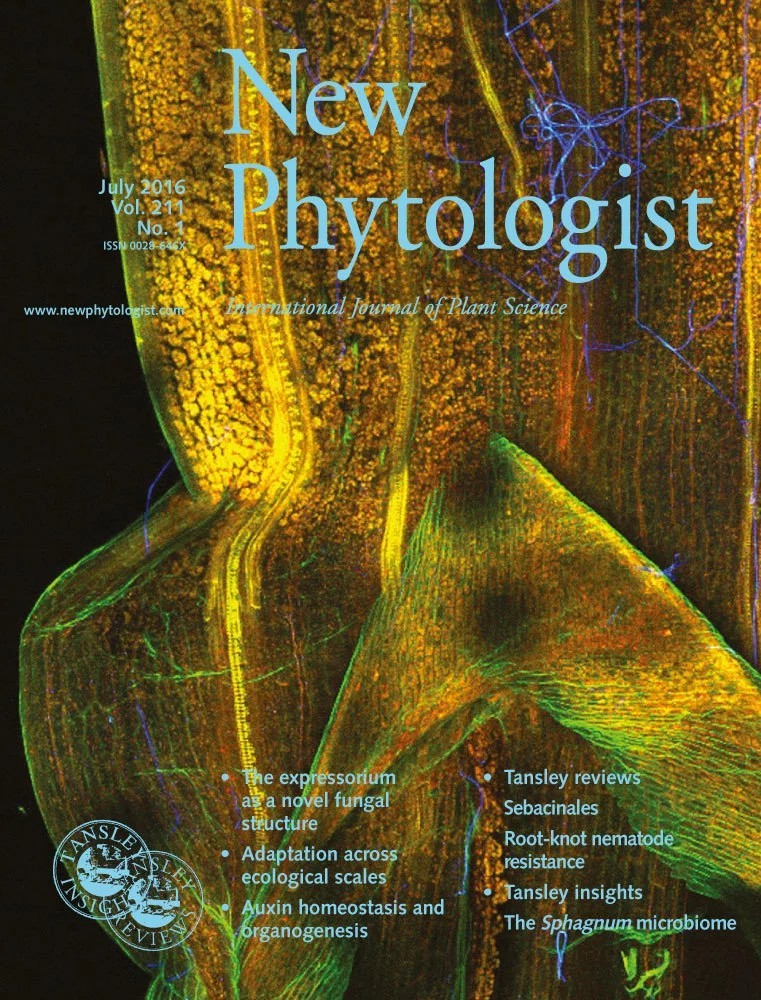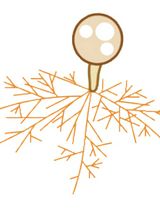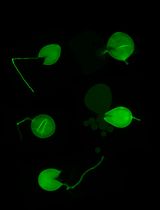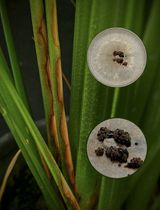- EN - English
- CN - 中文
Artificial Inoculation of Epichloë festucae into Lolium perenne, and Visualisation of Endophytic and Epiphyllous Fungal Growth
人工接种羊茅香柱菌到麦黑草,并可视化观察内生真菌和叶生真菌的生长
发布: 2018年09月05日第8卷第17期 DOI: 10.21769/BioProtoc.2990 浏览次数: 9929
评审: Amey RedkarCynthia L. MonacoSatyabrata Nanda
Abstract
Natural hosts for the fungal endophyte Epichloë festucae include Festuca rubra (fine fescue) and Festuca trachyphylla (hard fescue). Some strains also form stable associations with Lolium perenne (perennial ryegrass). L. perenne is a suitable host to study fungal endophyte–grass interactions, such as endophytic fungal growth within the plant and epiphyllous growth on the plant surface. Here we provide a detailed protocol based on work by, for artificial inoculation of E. festucae into L. perenne, and newly developed staining and visualization techniques for observing endophytic and epiphyllous hyphae and the expressorium, an appressorium-like structure used by the fungus to exit the plant. The staining method uses a combination of glucan binding aniline blue diammonium salt (AB) and chitin binding wheat germ agglutinin-conjugated Alexa Fluor®488 -(WGA-AF488). This protocol will be a useful tool to study Epichloë-grass interactions, particularly the comparison of different Epichloë-grass associations, various endophyte-host developmental stages, as well as the analysis of mutant Epichloë strains.
Keywords: Expressorium (附着样胞)Background
Latch and Christensen (1985) developed a protocol for artificial infection of grasses with Epichloë endophytes. This work has been the basis for the extensive E. festucae Fl1–L. perenne symbiosis research (reviewed in Scott et al., 2012). In our recent work, we described a newly identified fungal structure, the expressorium that enables E. festucae to exit L. perenne (Becker et al., 2016). For visualization of fungal and plant structures, we used two different fluorophores. Wheat germ agglutinin-conjugated Alexa Fluor®488 (WGA-AF488) binds to sialic acid and N-acetylglucosamine residues and is commonly used as an indicator for chitin (Figueroa-Lopez et al., 2014). Aniline blue diammonium salt (AB) is commonly used as a stain for β-D-1,3-glucans, such as callose at plant cell walls and related glucans in fungal cell walls (Wood and Fulcher, 1984). Staining of ethanol and potassium hydroxide (KOH) cleared (i.e., fixed) plant samples with AB and WGA-AF488, as per our protocol described below, enables a comprehensive visualisation of (i) Epichloë endophytic and epiphytic hyphae, (ii) plant responses based on callose depositions, and (iii) the plant cuticle. By collecting a combination of light emitted from the dyes described here and autofluorescence from the host plant, we can observe a strong signal from the plant cuticle. This overcomes the need for a specific dye for lipophilic components, which might interfere with WGA-AF488 or aniline blue imaging. Interestingly, WGA-AF488 exclusively stains the cell wall of epiphyllous Epichloë hyphae and is restricted to hyphal septa and actively growing tips of endophytic hyphae, while AB is used to stain the endophytic hyphal cell wall and plant glucans. Propidium iodide (PI), which stains plant and fungal nuclei, can also be used in combination with WGA-AF488 and AB without the need for changing the confocal settings described below.
Materials and Reagents
Seed sterilization and inoculation:
- 1.5 ml reaction tubes (BRAND, catalog number: 780400 )
- Parafilm (Sigma-Aldrich, catalog number: P7793-1EA )
- Petri dishes (SARSTEDT, catalog number: 82.1472 )
- Household aluminum foil, or heavy duty foil for multiple uses
- Sterile filter paper (GE Healthcare, catalog number: 1001-090 )
- Potting mix (e.g., Klasmann and Deilmann, Substrat 1.090)
- Microscope slides (Carl Roth, catalog number: 0656.1 )
- Microscope slides coverslips (Carl Roth, catalog number: 0657.2 )
- Replacement blade No.11 for metal scalpel 10621 (DAHLE, catalog number: 10722 )
- Root trainers or pots (Gärtner Pötschke, catalog number: 280686 )
- Grass seeds (used here: Lolium perenne cv Samson seeds, endophyte free; Agricom, New Zealand)
- An Epichloë strain, E. festucae Fl1 (ATCC, catalog number: MYA-3407 )
- Autoclaved distilled water
- Murashige and Skoog Medium including vitamins (Duchefa Biochemie, catalog number: M0222 )
- Phyto agar (Duchefa Biochemie, catalog number: P1003 )
- Potato Dextrose Agar (Carl Roth, catalog number: X931 )
- Agar-Agar (Carl Roth, catalog number: 6494 )
- Sodium chloride (NaCl) (Sigma-Aldrich, catalog number: 793566 )
- Potassium chloride (KCl) (Sigma-Aldrich, catalog number: 746436 )
- Disodium hydrogen phosphate (Na2HPO4) (Sigma-Aldrich, catalog number: 795410 )
- Potassium dihydrogen phosphate (KH2PO4) (Sigma-Aldrich, catalog number: 795488 )
- Sulfuric acid (H2SO4) (Sigma-Aldrich, catalog number: 339741 )
- Sodium hypochlorite (NaClO + H2O; 12% Cl2) (Carl Roth, catalog number: 9062.3 )
- Potassium hydroxide (KOH) (Carl Roth, catalog number: 6751 )
- 95% Ethanol (Carl Roth, catalog number: 9065 )
- Tween 20 (Carl Roth, catalog number: 9127 )
- Glycerol (Carl Roth, catalog number: 7530 )
- Aniline Blue diammonium salt (C37H32N5O9S3) (Sigma-Aldrich, catalog number: 415049 )
- Wheat Germ Agglutinin, Alexa FluorTM 488 Conjugate (Thermo Fisher Scientific, catalog number: W11261 )
- Propidium iodide solution 0.5 mg/ml (Sigma-Aldrich, catalog number: P4864 )
- 3% water agar (see Recipes)
- 2.4% potato dextrose agar (see Recipes)
- Murashige and Skoog phyto agar (see Recipes)
- Aniline Blue diammonium salt stock solution (see Recipes)
- WGA-AF488 stock solution (see Recipes)
- PBS (pH 7.4) (see Recipes)
- Tween 20 stock (see Recipes)
- Staining Solution (see Recipes)
Equipment
- Fridge
- Incubator (Thermo Fisher Scientific, Heraeus, model: BK 600 )
- Stereomicroscope (Leica, model: Leica S6 D )
- Metal scalpel (DAHLE, catalog number: 10621 )
- Preserving jar
- Autoclave
- Stainless steel forceps (Sigma-Aldrich, catalog number: Z168777 )
- Thermos Scientific “Mr. Frosty” Freezing Container (Thermo Fisher Scientific, catalog number: 5100-0001 )
- Laminar air flow cabinet
- Confocal Laser Scanning Microscope, CLSM, (Leica, models: Leica TCS SP5 and Leica TCS SP8 )
- Desiccator Base (DWK Life Sciences, DURAN®, catalog number: 247714605 )
- Desiccator Lid (DWK Life Sciences, DURAN®, catalog number: 244204605 )
- Stopcock with PTFE Spindle (side) (DWK Life Sciences, DURAN®, catalog number: 247980306 )
- Stopcock with PTFE Spindle (top) (DWK Life Sciences, DURAN®, catalog number: 247990401 )
- Water jet filter pump (BRAND, catalog number: 159600 )
Procedure
文章信息
版权信息
© 2018 The Authors; exclusive licensee Bio-protocol LLC.
如何引用
Becker, Y., Green, K. A., Scott, B. and Becker, M. (2018). Artificial Inoculation of Epichloë festucae into Lolium perenne, and Visualisation of Endophytic and Epiphyllous Fungal Growth. Bio-protocol 8(17): e2990. DOI: 10.21769/BioProtoc.2990.
分类
微生物学 > 微生物-宿主相互作用 > 真菌
植物科学 > 植物细胞生物学 > 细胞染色
细胞生物学 > 细胞染色 > 几丁质
您对这篇实验方法有问题吗?
在此处发布您的问题,我们将邀请本文作者来回答。同时,我们会将您的问题发布到Bio-protocol Exchange,以便寻求社区成员的帮助。
Share
Bluesky
X
Copy link













